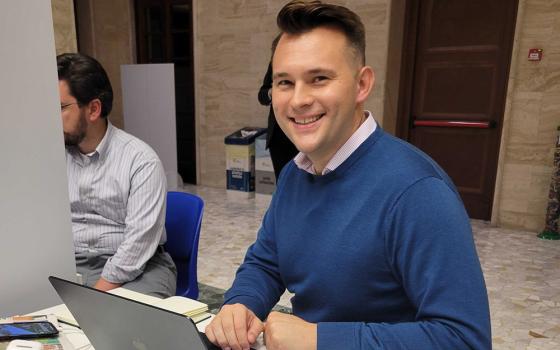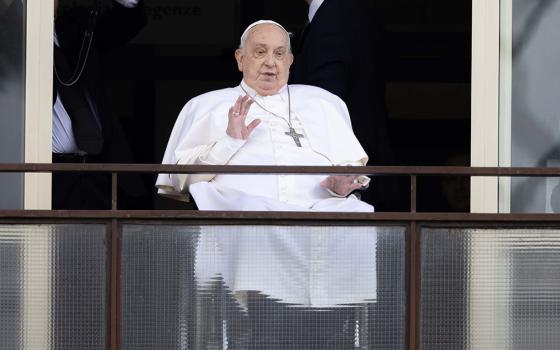For weeks I had been reading about the protests taking place on Wall Street. But I didn’t really take notice until October 1, when nearly 15,000 protesters were marching practically over my head as I attended a wedding at a restaurant just below the Brooklyn Bridge.
The demonstration resulted in the arrest of over 700 people. While they were on the Manhattan side of the bridge, police pepper-sprayed the crowds and swung batons at those who crossed barricades. A day earlier eyewitnesses reported that one officer forced women into pens and sprayed mace in their faces at close range.
Videos of these ugly scenes have been posted on YouTube. Though the images are difficult, in many ways those batons elicited shots that were quickly heard around the world.
By the following Wednesday, dozens of unions and activists groups organized to march in solidarity with Occupy Wall Street.
Brendan Fay, a filmmaker and Catholic gay activist, said it was those images of pepper spray and batons that “stirred him from the couch to the streets.” For Fay, the event “was like an awakening on Wall Street. This is a moment and an opportunity for churches and communities to reflect on the current economy as working for change…We know can do better. We must do better.”
Occupy Wall Street is also shaping up to be a defining moment for young adults, known commonly as the Millennial generation, in the U.S. This generation, often criticized for numbing themselves with video games, text messages and reality television, suddenly finds itself to be the prime mover in perhaps the most promising protest movement to sweep the country in decades.
They are doing what politicians and elected leaders continue to fail to do: they're hearing the voice of the majority of Americans and are taking action on their behalf. And with their idealism and youthful ability to camp out indefinitely in a Manhattan park, they have inspired Americans across age, racial-ethnic, and religious boundaries.
When I joined the demonstration last Wednesday evening, I was stunned by the stark contrast between many of the mainstream news reports about the protesters and what I actually witnessed in and around Zuccotti Park.
Rather than a great sea of unwashed, ne’er-do-wells, I encountered instead a spectrum of individuals reflecting the true face of America.
Middle aged Hispanic men who had the look of laid-off construction workers chanted a message to the president: “Obama, eschucha! Estamos en la lucha!” (Obama, listen! We are in the struggle!)
Behind them marched young Muslim women wearing the hijab. They carried a banner reading “The people united, will never be defeated.”
A young Korean woman shouted into a mega phone, “Show me what democracy looks like!” A group of Asian twenty-somethings, wearing bright orange vests with the word “justice” embroidered on the back, replied, “This is what democracy looks like!”
An elderly woman in stood in the midst of the marchers, waving a flag at protesters that read, “I’m 87 and mad as hell!”
Though some protesters also advocated for other causes such as environmental protection and stopping animal cruelty, all seemed united in the desire for economic justice and equal representation by their elected leaders. The call themselves the 99 percent, because they believe that 1 percent of the U.S. population controls an incongruous amount of the country’s wealth.
One demonstrator, Robert Pinter, summed up the cause as an attempt to “to stand up to the corrupt and failing ‘corporatocracy’ that we the taxpayers financed and saved after the crash of 2008.”
Like so many fellow occupiers of Wall Street, Pinter believes that the “lust for power and profit above all else has destroyed the working and middle classes. It has led to an erosion of our democracy and the ethics and values that used to guide us.”
The leadership body behind Occupy Wall Street remains somewhat ambiguous by organizational standards, and they have yet to articulate their key goals. This could partly be due to the unexpected speed and size of the response to the movement.
But it also reflects the leadership style that the Millennial generation seems to prefer. According to an Occupy Wall Street FAQ posted on The Nation website, the de facto decision-making body for the movement is known as the “General Assembly,” which they define as “a horizontal, autonomous, leaderless, modified-consensus-based system with roots in anarchist thought.”
Interestingly, most Millennials I’ve talked to about the future of church leadership seem to envision a similar model.
Yet, for all of their ambiguous leadership, the group has also proven to be quite shrewd. They have been quick to defuse claims by critics that occupiers are little more than lazy, unclean, drugged-up hippies. When complaints arose about unsanitary conditions in the Zuccotti Park, they created a sanitation committee. A team of volunteers regularly sweeps the grounds and quickly removes accumulating garbage. Those who show up drunk or high are promptly asked to leave. And, of course, they are brilliant with social media and web streaming.
Yes, there are some freaky people in the crowd. But this typically comes with the “radical action” territory. And it’s important to bear in mind that many of the occupiers are staging a long-term sit-in on New York City streets. Who wouldn’t look a little rough around the edges?
Most of the occupiers I met were well informed, articulate, and justice-oriented. And they all shared one reality in common: an inauspicious future. They have been told that the America in which their parents were raised is not the same country that they will inherit. They have been told not to expect basic entitlements like social security, and they watch powerlessly as their elders lose pensions and retirement accounts.
It is a future that is not only bleak, it also seems increasingly out of their control. Millennials are coming into adulthood in a nation whose superpower status is gradually being compromised by a failing education system, a dearth of manufacturing industries, an eroding infrastructure, out-dated mass transit systems, and a severely polluted environment. Like most Americans, they realize that they are being led through this mess by elected officials who seem unconcerned with their needs and desires.
The support that Occupy Wall Street is garnering seems to be helping them shape their priorities. Among the goals being discussed by the General Assembly is pushing to resurrect the fight to increase taxes on the wealthiest Americans.
This issue was among the most painful losses during this summer’s war over the budget. The fight was lost largely because of the Tea Party’s hijacking of the entire budget process -- and because the president, it must be said, allowed them to get away with it.
This failed attempt at a just budget plan was likely one of the galvanizing forces behind Occupy Wall Street. But, ironically, the Tea Party itself may have also inadvertently provided this new movement with one of the most important models.
One of the greatest obstacles faced by liberal causes over the past few decades has been an inability to organize around issues. Liberals are often, by their very nature, non-conformists. Movements like the Tea Party, and other political causes fueled by the religious right, rest on the power of absolutism. It’s much easier to organize people who see the world as black and white.
The Tea Party movement showed us the power of mobilization. So far, Occupy Wall Street seems to be successful in shaking off the complacency that has mired down so many Americans, and in getting folks from varied walks of life to rally around one, crucial issue.
Even Republican House Majority Leader Eric Cantor had to admit this weekend that the movement is beginning to make him nervous.
It will be interesting to see if the consensus model eventually compromises Occupy Wall Street’s power to organize and mobilize. As we all learned last week, part of Steve Jobs success was his genius and creativity. But a good portion of it was also a result of his controlling, authoritarian leadership style.
If Jobs had to work on a consensus model, the iPhones and iPads that have been crucial to organizing this movement still might not exist. His untimely death leaves us to dream of what a different world it could be if more micro-managers also had genuine talent.
Only time will tell if Occupy Wall Street can make passionate ideals and consensus style leadership a high-impact enterprise.
One very healthy sign is that Occupy Wall Street seems to be inspiring the creation of a multitude of movements throughout the country and even in other parts of Manhattan. On Tuesday, a group of protesters made house calls to some of New York’s wealthiest residents. They walked miles to the Upper East Side to protest in front of the multi-million dollar townhouses of media mogul Rupert Murdoch and J.P. Morgan Chase Chair and CEO Jamie Dimon.
They were protesting the possible expiration of a New York State surcharge on households with an annual income of more than $1 million.
As the Upper East Side protests were taking place, over in East Harlem, about twenty blocks to the north, a pilot program that offers a free, half-gallon of milk to needy families was in full swing. The line stretched for three city blocks. The milk ran out well before all were accommodated.
It was yet another sign of just how long an occupation this may have to be.
[Jamie L. Manson received her Master of Divinity degree from Yale Divinity School where she studied Catholic theology and sexual ethics. Her columns for NCR earned her a first prize Catholic Press Association award for Best Column/Regular Commentary in 2010.]
| Editor's Note: We can send you an e-mail alert every time Jamie Manson's column, "Grace on the Margins", is posted to NCRonline.org. Go to this page and follow directions: E-mail alert sign-up. If you already receive e-mail alerts from us, click on the "update my profile" button to add "Grace on the Margins" to your list. |




